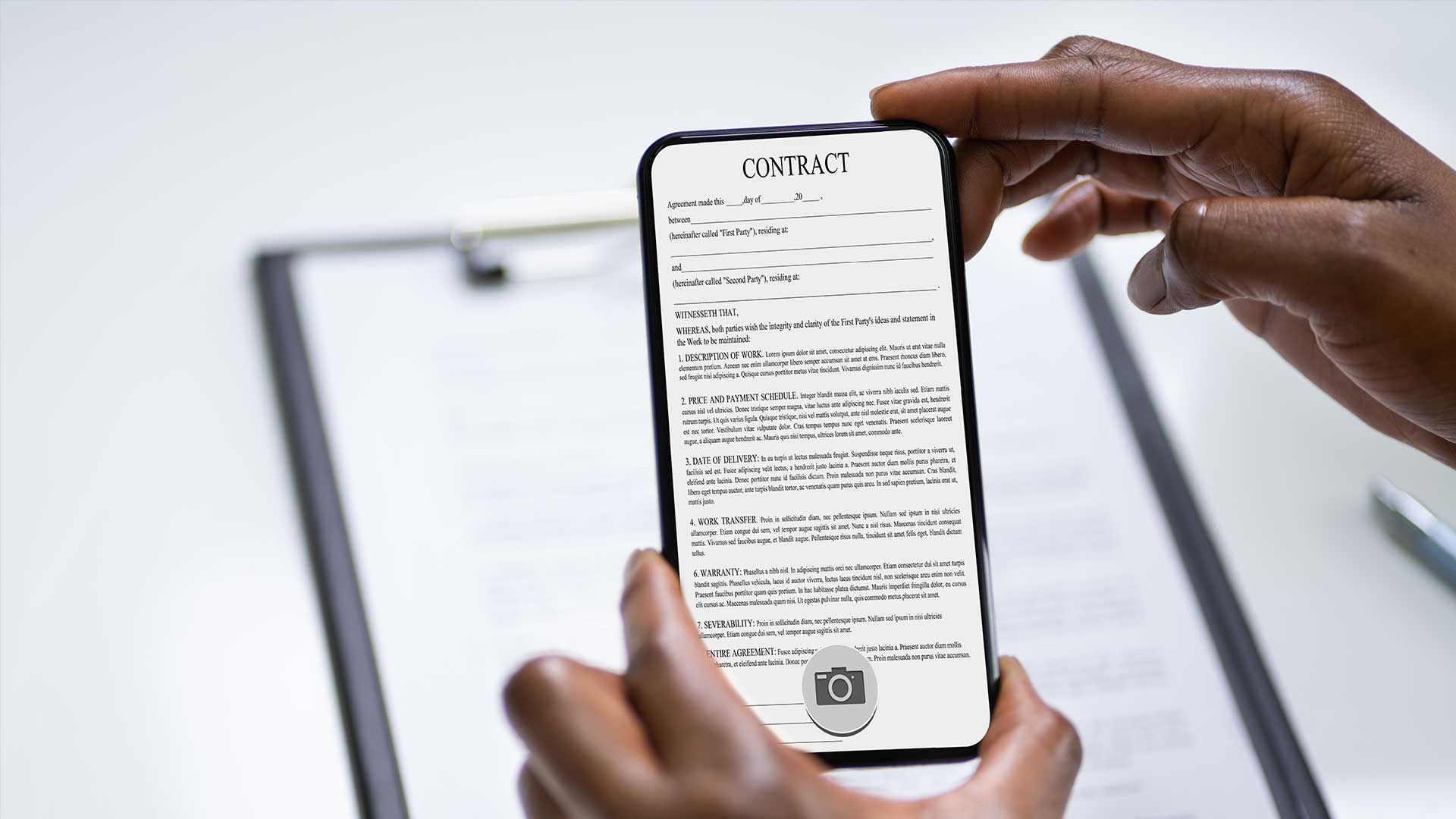Advanced OCR Technology in Document Scanning
Table of contents
In the relentless march toward digital transformation, businesses and industries are adopting technologies that streamline operations, enhance efficiency, and safeguard vital information. At the heart of this shift is the seemingly mundane yet crucial process of document scanning, a gateway to digitizing the physical world of paperwork. Its significance is amplified by the evolution of Optical Character Recognition (OCR) technology, a cornerstone in the bridge between analog documents and digital data management.
The importance of document scanning cannot be overstated in today's digital ecosystem, serving as the first step in data processing and archiving. OCR technology, in particular, has undergone a remarkable evolution, transforming from a simple text recognition tool to a sophisticated system capable of deciphering complex layouts and scripts with high accuracy. This leap in technology is revolutionizing document management, especially for sectors like architectural firms and construction companies, where the need for precision and efficiency in handling vast amounts of documents is paramount.
Advanced OCR technology is not just about converting images into text; it's about creating a seamless flow of information that enhances decision-making and operational processes. For industries reliant on detailed plans, contracts, and reports, such as architecture and construction, the advent of advanced OCR solutions marks a pivotal shift toward more streamlined, error-free document management systems.
As we delve into the specifics of OCR technology and its impact on document scanning and management, it's crucial to understand the mechanics behind it, its historical progression, and its current and future applications. This article aims to shed light on how advanced OCR technology is reshaping the way architectural firms and construction companies manage their documents, ensuring that vital information is accessible, editable, and secure.
Understanding OCR Technology
Optical Character Recognition (OCR) technology is a pivotal innovation that serves as the backbone of effective document digitization. At its core, OCR is designed to convert different types of documents—whether handwritten, typed, or printed—into machine-readable text. This capability is not just about recognizing characters on a page; it's about transforming static documents into dynamic, editable, and searchable data, marking a significant leap in information management and accessibility.
The Evolution of OCR Technology
The journey of OCR technology is a testament to the advancements in computational capabilities and artificial intelligence. From its early days in the 1950s, when it was primarily used to assist visually impaired individuals by converting simple text into speech, OCR has evolved into a sophisticated tool capable of recognizing and interpreting a wide range of fonts, languages, and even handwritten text. This evolution has been fueled by the relentless pursuit of more accurate, efficient, and versatile document management solutions.
How OCR Works
OCR technology operates through a series of complex steps, beginning with the scanning of a document to create a digital image. This image is then analyzed, with the OCR software identifying and segmenting each character. Through pattern recognition and artificial intelligence algorithms, the software interprets these characters, converting them into digital text. This process not only makes the text editable and searchable but also preserves the layout and formatting of the original document, ensuring that the digital version is a true reflection of the original.
The ability to convert various document types into a digital format has profound implications for data management. For industries inundated with paperwork, such as architectural firms and construction companies, OCR technology offers a streamlined approach to document handling, from contracts and blueprints to reports and correspondences.
The Role of Advanced OCR in Document Scanning
The landscape of document scanning has been dramatically transformed by the advent of advanced OCR technology. This evolution has not only enhanced the accuracy of text recognition but has also introduced a suite of features that cater to the diverse needs of modern businesses, particularly in the architectural and construction sectors.
Advanced Features of Modern OCR Technology
Modern OCR technology stands out for its improved accuracy, extensive language support, and the ability to recognize and process complex document layouts. These advancements have been fueled by innovations in artificial intelligence and machine learning, enabling OCR systems to learn from vast datasets and improve over time. Today's OCR can handle a variety of document types, from simple printed texts to intricate handwritten notes, and even documents with mixed media and layouts, such as invoices, architectural plans, and contracts.
One of the most significant advancements in OCR technology is its context-aware recognition capabilities. This feature allows OCR systems to understand the context in which words and phrases appear, greatly enhancing the accuracy of text conversion, especially in documents with specialized terminologies, such as architectural designs and construction documents.
Benefits of Using Advanced OCR in Document Scanning
The adoption of advanced OCR technology in document scanning processes offers myriad benefits:
- Time Savings: Automating the conversion of physical documents into digital formats significantly reduces the time required for data entry and document processing.
- Reduced Errors: Advanced OCR minimizes human error in data transcription, ensuring higher accuracy in document management.
- Enhanced Data Management: Digital documents can be easily searched, retrieved, and analyzed, improving accessibility and usability of information.
Case Studies: Impact on Architectural Firms and Construction Companies
Architectural firms and construction companies are leveraging advanced OCR technology to streamline their document management processes. For instance, an architectural firm might use OCR to digitize decades of blueprints and design documents, making them easily searchable and editable. This capability is crucial for referencing past projects, complying with regulations, and ensuring design consistency.
Construction companies benefit similarly by digitizing contracts, work orders, and site plans. This digitization enables quick revisions, enhances collaboration among stakeholders, and simplifies compliance tracking. An example is a construction company that integrated OCR technology into its project management software, allowing for real-time updates to documents and plans, significantly reducing delays and communication errors on site.
Integrating OCR Technology with Document Management Systems
Integrating Optical Character Recognition (OCR) technology into document management systems marks a significant leap towards operational efficiency and data accessibility. This integration is not just about converting documents into digital formats but about embedding intelligent, searchable, and manageable data into the everyday workflow of businesses.
The Integration Process
The process of integrating OCR technology into an existing document management system involves several key steps, beginning with the selection of the right OCR software that aligns with the organization's needs. This selection is critical and should consider factors such as the accuracy of the OCR, the languages supported, the ability to recognize complex document layouts, and the ease of integration with current systems.
Once the appropriate OCR solution is chosen, it's integrated with the document management system through APIs or middleware. This integration allows for the seamless flow of data between the OCR software and the document management platform, enabling documents scanned via OCR to be automatically indexed, categorized, and stored in the right location within the system.
Advantages of OCR Integration
- Streamlined Workflows: Automated document processing reduces manual data entry and file organization tasks, allowing employees to focus on more strategic activities.
- Enhanced Collaboration: With documents converted into editable and searchable formats, team members can easily access and collaborate on projects, regardless of their physical location.
- Efficient Document Retrieval: The searchability of digitized documents significantly reduces the time spent looking for information, improving productivity and decision-making speed.
Best Practices for Implementing OCR Solutions
Implementing an OCR solution successfully requires careful planning and execution. Key best practices include:
- Choosing the Right OCR Software: Assess the software's compatibility with your existing document management system and its ability to meet your specific document processing needs.
- Training Staff: Ensure that staff are adequately trained on how to use the OCR system effectively, focusing on how to prepare documents for scanning and how to manage digital files post-conversion.
- Maintaining Data Security: Given the sensitive nature of many documents, it's vital to choose OCR solutions that comply with data protection regulations and to implement secure data storage and access protocols.
Architectural firms and construction companies, in particular, can benefit from the integration of OCR technology by enabling more efficient management of project documents, contracts, and blueprints, thereby saving time, reducing errors, and facilitating easier collaboration across project teams.
Future Trends in OCR and Document Scanning
As we navigate through the digital age, the evolution of Optical Character Recognition (OCR) technology continues to push the boundaries of what's possible in document scanning and management. With the integration of artificial intelligence (AI) and machine learning (ML), the future of OCR holds promising advancements that promise to further enhance accuracy, efficiency, and integration capabilities.
AI and Machine Learning Enhancements
The future of OCR technology is intricately linked with the advancements in AI and ML. These technologies are set to improve OCR accuracy significantly, especially in recognizing complex and low-quality documents. AI algorithms are being trained to understand context better, recognize nuances in different fonts and handwriting, and even correct errors by learning from corrections over time. This level of intelligence will enable OCR systems to process documents with a near-human level of understanding and accuracy.
Integration with Emerging Technologies
OCR technology is also expected to become more seamlessly integrated with other emerging technologies, such as blockchain for secure document verification and cloud storage for enhanced accessibility and collaboration. The integration with blockchain, for example, could revolutionize document authenticity and traceability, providing a secure and immutable record of document scans that could be vital for contracts and legal documents in the construction and architectural sectors.
Another exciting advancement is the potential for OCR to work hand-in-hand with augmented reality (AR) and virtual reality (VR), especially in architectural and construction industries. Imagine pointing your device at a physical blueprint or contract and seeing it augmented with digital overlays of project timelines, annotations, or 3D models, all made possible by OCR technology recognizing the text and integrating it with digital project management tools.
Automation and Accuracy Improvements
The push towards full automation in document management is another area where OCR technology is set to make significant strides. Future OCR systems will not only convert text from paper to digital form but will also categorize, file, and even summarize key information from documents automatically. This automation will streamline workflows like never before, reducing the need for manual intervention and allowing firms to focus on core project execution and innovation.
Moreover, as OCR technology becomes more sophisticated, we can expect substantial improvements in the accuracy of document scanning. This means fewer errors in the conversion process and a higher degree of reliability on digitized documents for critical decision-making processes.
The Future of Document Management
Looking ahead, the role of OCR in document management is poised to become more integral, with technologies converging to create a seamless, automated, and highly accurate system for managing documents. For architectural firms and construction companies, this means the ability to manage projects more efficiently, with immediate access to accurate and actionable data extracted from countless documents.
As we embrace these advancements, the potential for innovation in how documents are managed, shared, and utilized is limitless, promising a future where information is not just digitized but truly activated to drive decision-making and innovation.
Choosing the Right OCR Solution
For architectural firms and construction companies, the decision to implement Optical Character Recognition (OCR) technology can significantly influence their document management efficiency and overall project success. Given the myriad of OCR solutions available, selecting the right one requires careful consideration of several key factors.
Compatibility with Existing Systems
One of the first considerations should be the OCR solution's compatibility with your existing document management systems and workflows. The goal is to enhance and streamline operations, not to overhaul your current systems completely. Look for OCR software that easily integrates with your existing infrastructure, whether that's cloud-based storage solutions, project management tools, or other enterprise software.
Scalability
The chosen OCR solution should not only meet your current needs but also grow with your company. Scalability is crucial, especially for businesses in the architectural and construction sectors where project sizes and volumes can vary significantly. The right OCR software should be able to handle increasing volumes of documents without a drop in performance or accuracy.
Support and Training
Consider the level of support and training the OCR vendor offers. Implementing a new technology can come with a learning curve, and having access to comprehensive training resources and responsive customer support can make the transition smoother. This support is particularly important when integrating OCR technology into complex document management systems common in the construction and architectural fields.
Cost
Cost is always a consideration, but it should be weighed against the benefits and efficiencies the OCR solution brings. Cheaper options might not offer the advanced features or support you need, leading to more expenses in the long run due to inefficiencies or the need for additional software. Evaluate the pricing models carefully and consider the return on investment that a more capable OCR solution could provide.
Evaluating Vendors
When selecting an OCR solution, don't just focus on the software—consider the vendor's reputation, their commitment to innovation, and their understanding of your industry's specific needs. It's advisable to evaluate multiple vendors and test their solutions when possible. Look for reviews, case studies, and testimonials from other firms in your sector to gauge how well a particular OCR solution might work for you.
Consider solutions like DocCapture, which offer advanced OCR scanning technology tailored to the needs of architectural firms and construction companies. These solutions often come with features specifically designed to handle complex documents and layouts typical in these industries, providing a blend of accuracy, efficiency, and user-friendly interfaces.
Conclusion
The integration of advanced OCR technology into document management processes represents a significant step forward for architectural firms and construction companies. By choosing the right OCR solution, these businesses can transform their approach to document management, making it more efficient, accurate, and accessible. The future of document management is digital, and embracing these technologies is essential for staying competitive and efficient.
In a world where efficiency and accuracy are paramount, the role of advanced OCR technology in transforming document management processes cannot be overstated. For architectural firms and construction companies, adopting these technologies is not just about keeping up with the digital transformation; it's about leveraging the power of digital data to enhance project outcomes, reduce errors, and streamline operations.
Are you ready to elevate your document management processes and embrace the efficiency and accuracy of advanced OCR technology? Explore DocCapture's advanced OCR scanning technology solutions today. Visit our website for more information or to schedule a consultation. And if you're looking to get started right away, fill out our "get a quote" form to receive a personalized assessment and quotation tailored to your specific needs. Stay ahead of the curve with DocCapture, and transform your document management into a seamless, efficient process.
Share this
You May Also Like
These Related Stories

The Advantages of Using OCR Technology in Document Scanning Services

Optical Character Recognition OCR: Transforming Architectural Firms

